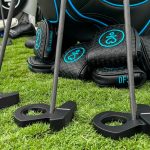DSW Inc. said that although traffic and sales improved in October, comparable sales decreased 0.7 percent in its third quarter. The off-price footwear chain consequently slightly lowered its sales guidance for the year.
DSW now expects flat same-store sales for the full year and adjusted sales growth of 6 percent-7 percent excluding the extra week from last year. That's down from the low-single-digit same-store-sales growth it forecast in August and 6 percent-8 percent adjusted sales growth. Its EPS range was kept at $1.80-$1.90, representing approximately 10 percent growth over last year's earnings. But that’s still down from Wall Street’s consensus estimate for the year of $1.90.
Adjusted for the subpar results of its luxury test and legacy charges from its merger with RVI, earnings rose 15.0 percent in the third quarter to $53.6 million, or 58 cents a share, in line with Wall Street estimates.
Revenues increased 6.8 percent to $633.0 million. The comp decline followed an increase of 6.3 percent in the 2012 third quarter. Store traffic declined, but was mostly offset by an increase in store conversion.
On a conference call with analysts, Mike MacDonald, DSW’s president and CEO, said weather stayed unseasonably warm through all of August and September and through the first week of October to contribute to comp declines. The partial government shutdown in early October also impacted sales.
DSW took selective price reductions in “sharpening our value messaging to the customer.” When the weather got colder and the government impasse ended, sales “bounced back” in the second week of October. Added MacDonald, “Of course, it remains to be seen whether that end-of-Q3 sales momentum will continue through Q4 as it did in Q2.”
Among categories, the big disappointment was women’s, which was down 5 percent and MacDonald said adjustments are being made. Inside women’s dress, which had been weak for the last four quarters as well, was down low double digits. Casual, which had generated 10 quarters of positive comps, was off mid-single digits, reflecting both weather issues and a lack of novelty in the area. Boots were relatively flat, with an influx of booties “working very well” and riding boots showing strong upside, Debbie Ferree, DSW’s chief merchandising officer, said on the call.
Much like the first half, men's footwear and accessories were strong, up 9 percent in each category in the period.
Athletic footwear was flat. Ferree said DSW was “relatively pleased” with the athletics performance with merchandise margins in the category up slightly. Athletics saw a “minor shift” with technical slowing down slightly. Ferree elaborated, “If you'll remember how we define technical, it's really the higher price points. But we are seeing continued strength and actually growth in cross training, lightweight running, basic running, and so we really don't really see any major shifts in that athletic business.”
She also said some athletics sales in men’s “could be transferring over to the men's black and brown business.”
By region, the west, the south and the northeast regions all posted low single-digit positive comp sales growth, while the mid-Atlantic and the midwest recorded mid-single-digit comp sales declines. Results in the Northeast were favorably affected by the impact of Sandy in the prior year.
Total gross profit decreased 20 basis points to 33.6 percent, due to a slight decrease in merchandise margin and occupancy deleverage. Merchandise margin rate was down 10 basis points to 45.9 percent.
DSW’s SG&A improved 130 basis points to 19.9 percent, driven by lower overall pre-opening, IT, and overhead expenses, as well as leverage in its marketing and store support expenses.
MacDonald noted that two small format stores of around 12,000 square feet opened in the quarter and performed line with expectations but “it's really very early to make a judgment as to their long-term sales potential.”
Regarding omni-channel initiatives, DSW has rolled out the ability to fulfill web orders using store inventory. Stores can also now fulfill out-of-stocks by reaching out to other stores. Its newer size optimization system has helped improve its in-stock rate by 2 percentage points on those items most directly affected by the system. One vendor has implemented drop-ship capacity, enabling web orders to be fulfilled by the suppliers warehouse. DSW hopes to get another 10 suppliers on drop-ship next year.
Asked whether the slowdown early in the quarter had more to do with the weather or the uncertain economy, MacDonald said DSW saw “some very nice check-outs in the west and the south where weather was pretty normal.” Sales also picked up in the other areas when it got colder.
At the same time, the challenges faced in the Mid-Atlantic certainly reflected the impact of the government impasse. Added MacDonald, “So, it's not strictly weather; there are some other factors and that's why I mentioned it in my remarks, because we didn't see it. And then with the northeast, the last week of the quarter was up against the brunt of Sandy last year so we got a little bit of a lift there in the northeast. But, generally, the midwest and the northeast and the mid-Atlantic were considerably weaker than the west and the south.”














